Fairey Barracuda III, Ballyell, Wexford, June 1945
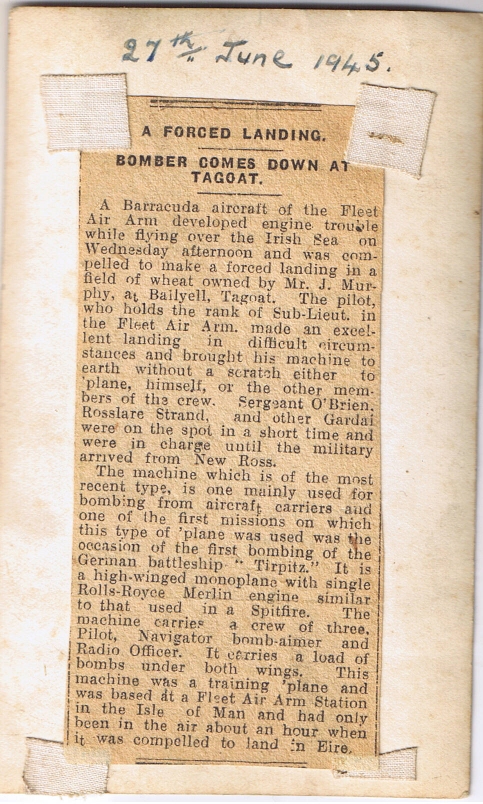 In the
month following the end of hostilities in Europe, air activity
continued around Ireland unabated, though combat missions were
no longer being flown. On Wednesday, 27th of June 1945, locals
from near the small village of Tagoat in Wexford were treated to
the spectacle of the landing in one of their fields of a
military aircraft. Local Farmer John Murphy who lived in the
townland of Ballyell, received the unexpected visitor in the
shape of a single engine Royal Navy torpedo bomber. The aircraft
carried a crew of three men and early on the scene were the
local Gardai, who guarded the aircraft and crew until a military
party arrived some time later. The captain of the aircraft
explained that he had been flying from the Isle of Man on a
training missions only to discover fumes in the cockpit about an
hour into the flight. The aircraft had suffered a leak in the
hydraulic system and the pilot deemed it necessary to make for
the nearest land as soon as possible. Roy Grummitt brought his
Barracuda in for landing at 14:40 that afternoon.
In the
month following the end of hostilities in Europe, air activity
continued around Ireland unabated, though combat missions were
no longer being flown. On Wednesday, 27th of June 1945, locals
from near the small village of Tagoat in Wexford were treated to
the spectacle of the landing in one of their fields of a
military aircraft. Local Farmer John Murphy who lived in the
townland of Ballyell, received the unexpected visitor in the
shape of a single engine Royal Navy torpedo bomber. The aircraft
carried a crew of three men and early on the scene were the
local Gardai, who guarded the aircraft and crew until a military
party arrived some time later. The captain of the aircraft
explained that he had been flying from the Isle of Man on a
training missions only to discover fumes in the cockpit about an
hour into the flight. The aircraft had suffered a leak in the
hydraulic system and the pilot deemed it necessary to make for
the nearest land as soon as possible. Roy Grummitt brought his
Barracuda in for landing at 14:40 that afternoon.
The crew were met my members of the local Garda, the Irish police force and they stayed with the crew until a party of the Irish Army arrived from Bawnjames Military Post located at Bawnjames House estate. The crew of three reported their problems to the officers of the party and were taken to Bawnjames for the night where they were accommodated. The technical problems were reported back to the Irish Air Corps and the following afternoon, three personnel from Baldonnel arrived to carry out repairs to the aircraft. While repairs were made, a long stretch of the hedge on the field was cleared to provide access for the aircraft to an adjacent field. The three British airmen were accommodated a second night locally, this time in a hotel in Rosslare town. Finally at non the following day following repairs and and the hedge clearance, the aircraft was able to take off again. The three men were no home and dry just yet because the weather conditions worsened during the day and they again had to divert this time to Collinstown aerodrome, now Dublin Airport. Their stay was short however as they were able to depart and return to the Isle of Man some three hours later.
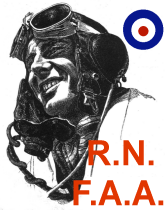 |
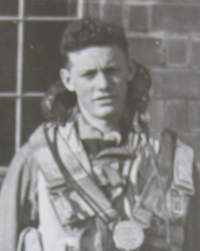 |
 |
| S/Lt (A) Roy David Grummitt, Pilot | Mids Gordon Campbell King, Observer (Navigator) | TAG George Goldsmith, Telegraphist/Air Gunner (TAG) |
The aircraft was identified as a Barracuda torpedo bomber,
serial number MD897. Ray Sturivant in his book, Fleet Air Arm
Aircraft 1939-1945 records the details of the specific
aircraft's history as follows, taken from Royal Navy, Fleet Air
Arm records:
One of 300 Barracuda III built by Boulton Paul at Wolverhampton.
Made ready for Collection, 27 Sep 1944. Assigned to 710/713/747
Sqns Ronaldsway October 1944 (issued unit code R5D)
Precautionary landing , hydraulic leak in cockpit, u/c damaged,
Ballyell, nr Broadway, Co. Wexford, Eire 27 June 1945.
The aircraft was seen by hundreds of local people and the daughter of the land owner, Una Murphy was able to take the following photos of the aircraft, clearly showing its fuselage markings of R5D. Also evident is the radar antennae mounted under the rear fuselage.
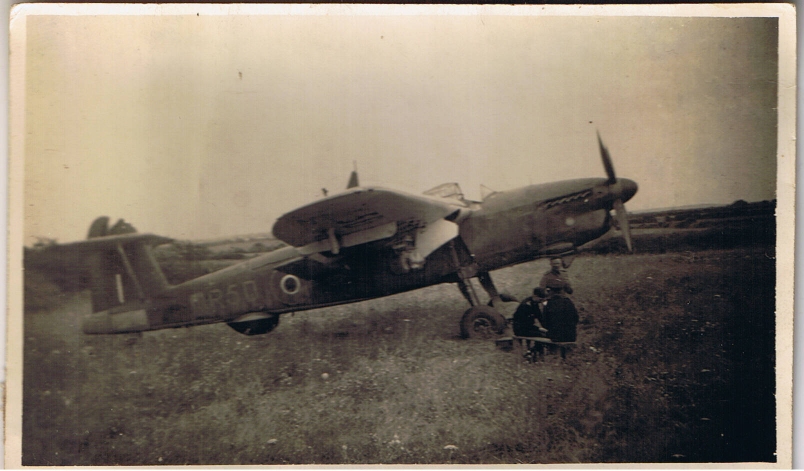
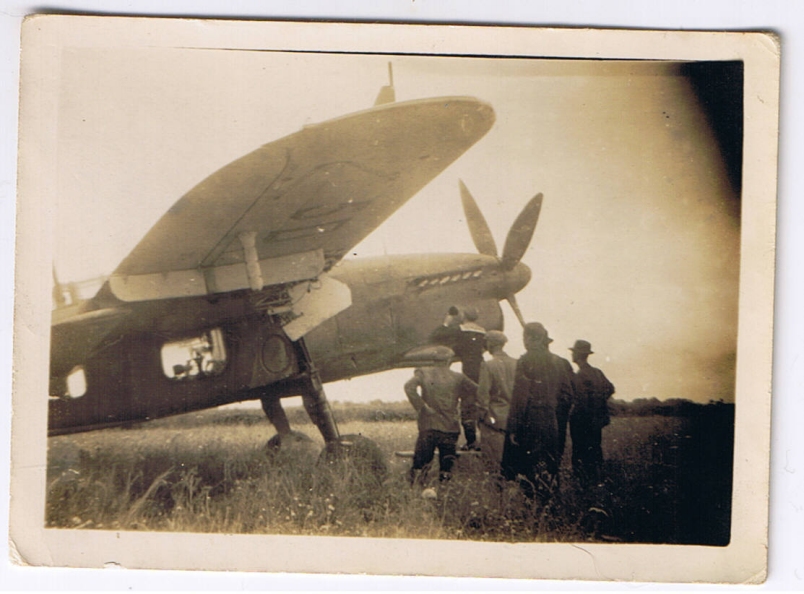
Roy David Grummitt was born in 1923, the son of Minnie and Aubrey Grummitt of Brighton. Roy trained in Canada at 31 Service Flying Training (SFTS)/14 SFTS, graduating on 6 October 1944.
The listing of three numbered 700 series squadrons relates that the three of them were grouped to form number 1 (Naval) Operational Training Unit. This permanently based group of about 100 Barracudas was based at Ronaldsway in the Isle of Man. This base was known as HMS Urley by the Royal Navy. It was here that airmen and officers trained in their various trades as pilots, navigators and gunners were brought together to form three man crews for the Fairey Barracuda torpedo bomber.
This was not Roy Grummitt's first incident with the Barracuda.
On the 23 May 1945, while with 767/769 Squadron undergoing deck
landing training, his aircraft, serial number DR148, had its
landing hook torn out causing the aircraft to crash into the
port walkway of HMS Smiter which was at that time assigned to
deck landing training. Roy would not live to see the anniversary
of his landing in Ireland. The National Probate Calendar of 1947
records his death as: GRUMMITT Roy
David of 84 Lowther-road Brighton died 10 June 1946 in an
incident in Surrey. Administration to Aubrey Grummitt
retired Grocer. His father Aubrey died only 18
months later with an address in Haugleton Road. The only
information known so far about his death is the annotation on
the naval-history.net
website, indicating that he died in a road accident. At the time
of his death, he was posted to HMS Gosling, the Royal Navy name
for a land based establishment at Risley, near Warrington. It
might be that he was posted there for administration purposes
and not actually located at the facility. His listings in the
1945 and 1946 Royal Navy Lists only show is promotion from
Acting Temporary Sub-Lieutenant (Air) to Temp. S/Lt (A) during
late 1945. His death was reported on by the Sutton &
Epsom Advertiser on the 20th June 1946.
MOTOR CYCLIST’S DEATH While motor
cycling along Long-down Lane Epsom towards Tadworth on
Whit-Monday Roy David Grummitt (20) a sub-lieutenant in the
Fleet Air Arm of Lowther Road, Brighton, came into collision
with a motor horse box and died from his injuries in the
County Hospital Epsom.
An inquest was opened hospital on Wednesday last adjourned
until to-morrow (Friday) after evidence of identification
had been given.
He is buried with his parents in Lewes
ROAD cemetery, Brighton.
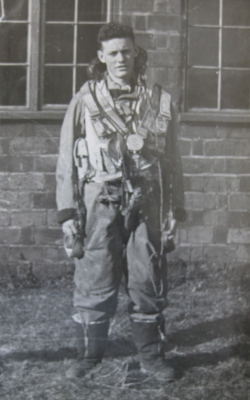 Gordon
Campbell King, was an officer also, and was the aircraft's
observer, or navigator. He was promoted to the rank of Temporary
Sub-Lieutenant, the standard rank assigned to most Royal Navy
Volunteer Reserve, Fleet Air Arm pilots and observers. One year
after the landing in Ireland, the Navy lists show him to be
serving in HMS Gannet, the shore station at Eglington in
Northern Ireland, with 744 Squadron. He remained listed a
reserve officer until at least 1958 in the Government Navy
lists. Beyond that, little else is known of Midshipman King.
Gordon came from Norfolk and died in 2003. His son was kind
enough to make contact and provided the photos of his father and
also one of the aircraft in the field in Wexford. It is not
clear if this was taken by Gordon or sent to him by a local
person.
Gordon
Campbell King, was an officer also, and was the aircraft's
observer, or navigator. He was promoted to the rank of Temporary
Sub-Lieutenant, the standard rank assigned to most Royal Navy
Volunteer Reserve, Fleet Air Arm pilots and observers. One year
after the landing in Ireland, the Navy lists show him to be
serving in HMS Gannet, the shore station at Eglington in
Northern Ireland, with 744 Squadron. He remained listed a
reserve officer until at least 1958 in the Government Navy
lists. Beyond that, little else is known of Midshipman King.
Gordon came from Norfolk and died in 2003. His son was kind
enough to make contact and provided the photos of his father and
also one of the aircraft in the field in Wexford. It is not
clear if this was taken by Gordon or sent to him by a local
person.
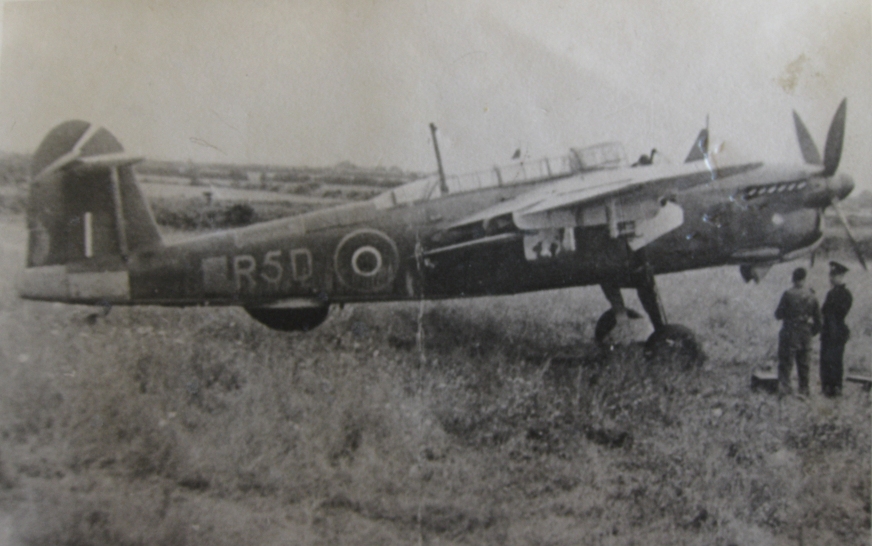
The remaining crew member is not confirmed in their identity. George Goldsmith the Telegraphist/Air Gunner cannot be easily identified as the name is rather common and no other information is known, such as an address or serial number. He would have been the rear gunner for the aircraft and would also have operated the radio equipment.
Compiled by Dennis Burke, 2015, Dublin and Sligo. With thanks to the family of Gordon King and Una Murphy
